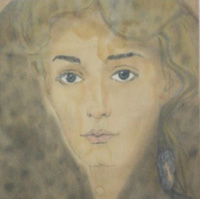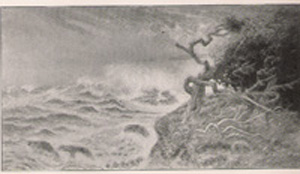Art Directed by Spirits?
Posted on 22 August 2011, 17:40
About 10 years ago, I met a woman I’ll call Hilda – the mother of an in-law – who told me that sometime around 1981, while watching television, she had the sudden urge to start writing a story – a story having to do with outer space. She had no real interest in the subject and had no prior interest in creative writing. “But I felt compelled to write,” Hilda told me. Words began flowing from Hilda’s pen, including many technical words that had no meaning to her. Her husband retired for the night and when he awoke the next morning Hilda was still writing. “I had lost track of time,” she explained. “I had no idea it was already morning.” She did not know what she had written, and when she read it she didn’t completely understand it.
When Hilda mentioned her strange experience to her fundamentalist pastor, she was informed that whatever was happening to her was demonic and that she should immediately desist, which she did. About 10 years later, when she was around 60, Hilda suddenly discovered that she had artistic ability. Although I am no judge of art, her paintings certainly indicate exceptional talent. Hilda decided to polish her painting skills by enrolling in some art classes. However, when she realized that the classes were negatively affecting her artistic ability, she discontinued them.
My guess is that Hilda is a natural medium and that the initial writing experience was automatic writing – a spirit using her hand while she was in an altered state of consciousness. Considering the fact that she had displayed no previous artistic ability, the paintings also seem to have been directed by a spirit. The fact that the classes negatively affected her ability seems to lend itself to this theory. That is, the artist in spirit did not want to change his style.
Marianne was her name
Very recently, Dr. Paul Biscop, (pictured below) a retired cultural anthropologist living in Nanaimo, Vancouver Island, told me a story that suggests spirit influence of some kind. When he was 17 in 1960, Paul felt compelled one day to do a portrait in pencil and pastel chalk. A portrait of a young woman emerged from his mind (also pictured below). ”I did not know why I seemed compelled to do this portrait – it was an unusual experience – nor did I know who she was,” Paul explained. “I knew only that I had a strong connection to the picture, and I called her ‘Marianne,’ after a Harry Belafonte song of the time (‘down by the sea side sifting sand…’) Over the years I assigned several mythical personae to her, depending on my interests of the time.”


Nine years later, during 1969, Paul was exploring mediumship in a spiritualist church in Montreal, Quebec and was given a personal demonstration by a medium who claimed to work with a group of spirits calling themselves “Tonancas.” The medium asked his spirit guide a number of questions about Biscop, including names of deceased relatives and the name by which Biscop was known in the spirit world. “Unfortunately neither the names of deceased relatives, nor the names by which I was supposedly also known in spirit, made any sense to me,” Paul continued the story. “One detail, though, was interesting. I was told that I was also known by a name, ‘that was held dear to my mother’s heart,’ the name ‘Andrew.’” When Paul later asked his mother about the name, it made no sense to her, either.
Paul sat with other mediums and a number told him that he had a sister in spirit. One medium told him that his sister had never fully touched the earth plane. Here again was something that made no sense to him, until some 17 years after that 1969 sitting. When he was 43 years old, Paul was informed by his parents that he had been adopted at age five months. After recovering from the shocking revelation, he began searching for his biological parents. Working with Parent Finders Canada, he discovered that his biological mother had died. However, he was able to track down the executor of his birth mother’s estate. “While I was speaking on the phone to her, she mentioned that I would have had a sister, a few years older than me, who had lived only seven days, and her name was, ‘Marianne,’” he continued the spine-tingling story. “At that point I also knew that my birth mother’s father, my grandfather, was ‘Andrew’. The other names in the Tonancas documents were deceased birth family members, as I later discovered, and so Tonancas was right after all. If you were to look at the photos of my birth mother and her husband, you would see a striking resemblance to the young woman in my portrait, as you would see the strong resemblance of my own to my mother. So I did indeed have a very important connection to both the name of Andrew, and to an unknown sister, whose name was Marianne.”
A case from the records of the Society for Psychical Research
Many years earlier, Dr. James H. Hyslop, the founder and director of the American Institute for Scientific Research, which was devoted to the study of abnormal psychology and psychical research, reported on a case in which a man named Frederic L. Thompson, a New York City goldsmith, sought help because visions and hallucinations were threatening his sanity. Thompson informed Hyslop that beginning in 1905 he was “suddenly and inexplicably seized with an impulse to sketch and paint pictures.” Prior to that, he had no real interest or experience in art beyond the engraving required in his occupation. The impulses were accompanied by “hallucinations or visions” of trees and landscapes. He explained that he sometimes felt like a man named Robert Swain Gifford At times he would remark to his wife that “Gifford wants to sketch.”
Thompson had met Gifford some years earlier in the marshes of New Bedford, Massachusetts, as he was hunting and Gifford was sketching. Thompson recalled talking to Gifford for a few minutes on one occasion and just seeing him on a couple of other occasions. Also, he once called on Gifford to show him some jewelry, but that was the extent of their contact. During the latter part of January, 1906, Thompson saw a notice of an exhibition of Gifford’s paintings at an art gallery and went to see them. While looking at one of the paintings on exhibition, Thompson heard a voice in his ear saying, “You see what I have done. Can you not take up and finish my work?” It was after that that he learned that Gifford had died on January 15, 1905, some six months before he developed the interest in painting.
“Whether genuine or not it had sufficient influence on the mind of Mr. Thompson to induce him to go on with his sketching and painting,” Hyslop said of the voice. “From this time on the impulse to paint was stronger, and between this date and the next year he produced a number of paintings of artistic merit sufficient to demand a fair price on their artistic qualities alone, his story being concealed from all but his wife.”
When Thompson showed one of his paintings to an art connoisseur, he was told that it resembled the work of Gifford, even though Thompson made no mention of the Gifford influence. One vision of some gnarled oak trees especially haunted Thompson. He felt he had to find the scene and paint it. It was at this point that he contacted Hyslop. He sketched the gnarled oak trees for Hyslop (below), stressing that the need to find the trees and paint them was overwhelming him and causing him to lose interest in his job.

Since Hyslop had been studying mediumistic phenomena, he arranged to have Thompson sit with three different mediums. All three described someone present who was said to be fond of painting, although none of the three could get his name. One of them did, however, get his initials, R.S.G., for Robert Swain Gifford. One of the mediums described a group of oak trees, which Thompson recognized as those that he had been visualizing for over a year. She could not give a location, but said that one had to take a boat to get there and that it was near the ocean. The second medium also described what she said looked like gnarled old trees near the ocean. A number of other facts suggesting Gifford were also communicated.
Thompson thought the scene might be at Nonquitt, Massachusetts, where Gifford had a summer home which was accessible only by boat. He went there and found several of the scenes he had seen in his visions but not the gnarled oak trees. Inquiring then of Mrs. Gifford, he was told that Gifford’s favorite place was one of the Elizabeth Islands. While Thompson was visiting Mrs. Gifford, he was shown around Gifford’s old studio and was shocked to see three paintings there which were almost mirror images of those he had sketched during his “hallucinations,” one of a man with an ox team.”
Thompson then went to the Elizabeth Islands and found the gnarled oak trees on the island of Nashawena, a place he had never been. He immediately painted the scene ( below). He also found several other scenes he had sketched or painted. While viewing one of them, he heard a voice similar to the one he had heard at the art gallery say, “Go and look on the other side of the tree.” There he found Gifford’s initials carved in the bark of a beach tree in 1902.

“On any theory we ought to recognize that the identity of Mr. Gifford is clear,” Hyslop concluded. “There are perhaps no single incidents that would force one to accept this view, but their collective force is overwhelming and constitutes a mass of relevant hints inapplicable to any one else.”
While skeptics might claim that Thompson made up the whole story and that he actually visited the scenes beforehand and made the sketches he claimed came from his visions, Hyslop saw no motive for such a charade, nor could fraud explain how Thompson suddenly became an accomplished artist with no prior experience or training. Most of all, though, Thompson had no control over the sittings with the mediums, which were arranged and observed by Hyslop. If Thompson had been faking it, how did the mediums come up with so many similar hits?
“Superficially, at least,” Hyslop ended his report, “all the facts point to the spiritistic hypothesis, whatever perplexities exist in regard to the modus operandi of the agencies effecting the result.”
Michael Tymn is the author of The Afterlife Revealed: What Happens After We Die, Resurrecting Leonora Piper: How Science Discovered the Afterlife and Dead Men Talking: Afterlife Communication from World War I.
|